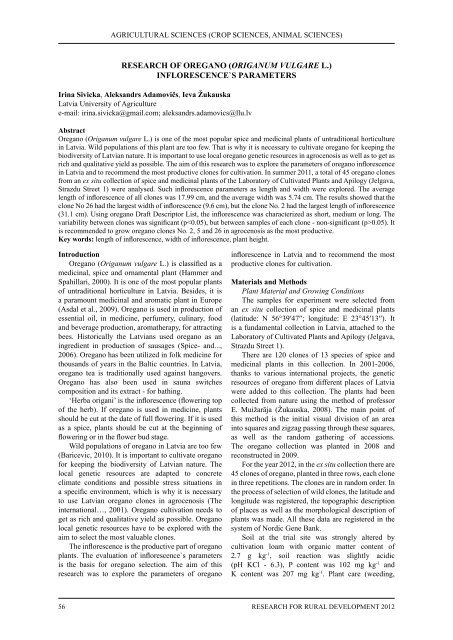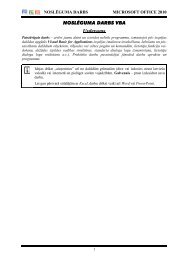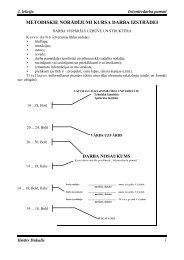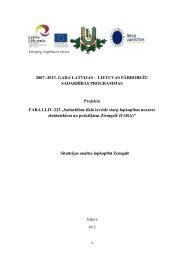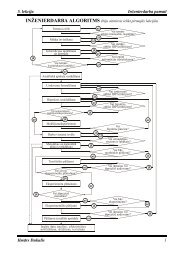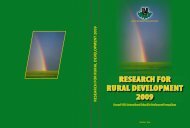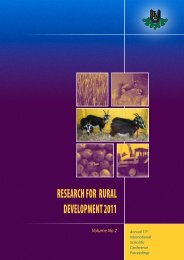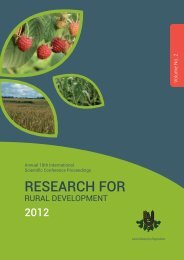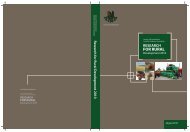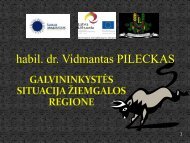LATVIA UNIVERSITY OF AGRICULTURE - Latvijas ...
LATVIA UNIVERSITY OF AGRICULTURE - Latvijas ...
LATVIA UNIVERSITY OF AGRICULTURE - Latvijas ...
- No tags were found...
You also want an ePaper? Increase the reach of your titles
YUMPU automatically turns print PDFs into web optimized ePapers that Google loves.
AGRICULTURAL SCIENCES (CROP SCIENCES, ANIMAL SCIENCES)RESEARCH <strong>OF</strong> OREGANO (ORIGANUM VULGARE L.)INFLORESCENCE`S PARAMETERSIrina Sivicka, Aleksandrs Adamovičs, Ieva ŽukauskaLatvia University of Agriculturee-mail: irina.sivicka@gmail.com; aleksandrs.adamovics@llu.lvAbstractOregano (Origanum vulgare L.) is one of the most popular spice and medicinal plants of untraditional horticulturein Latvia. Wild populations of this plant are too few. That is why it is necessary to cultivate oregano for keeping thebiodiversity of Latvian nature. It is important to use local oregano genetic resources in agrocenosis as well as to get asrich and qualitative yield as possible. The aim of this research was to explore the parameters of oregano inflorescencein Latvia and to recommend the most productive clones for cultivation. In summer 2011, a total of 45 oregano clonesfrom an ex situ collection of spice and medicinal plants of the Laboratory of Cultivated Plants and Apilogy (Jelgava,Strazdu Street 1) were analysed. Such inflorescence parameters as length and width were explored. The averagelength of inflorescence of all clones was 17.99 cm, and the average width was 5.74 cm. The results showed that theclone No 26 had the largest width of inflorescence (9.6 cm), but the clone No. 2 had the largest length of inflorescence(31.1 cm). Using oregano Draft Descriptor List, the inflorescence was characterized as short, medium or long. Thevariability between clones was significant (p0.05). Itis recommended to grow oregano clones No. 2, 5 and 26 in agrocenosis as the most productive.Key words: length of inflorescence, width of inflorescence, plant height.IntroductionOregano (Origanum vulgare L.) is classified as amedicinal, spice and ornamental plant (Hammer andSpahillari, 2000). It is one of the most popular plantsof untraditional horticulture in Latvia. Besides, it isa paramount medicinal and aromatic plant in Europe(Asdal et al., 2009). Oregano is used in production ofessential oil, in medicine, perfumery, culinary, foodand beverage production, aromatherapy, for attractingbees. Historically the Latvians used oregano as aningredient in production of sausages (Spice- and...,2006). Oregano has been utilized in folk medicine forthousands of years in the Baltic countries. In Latvia,oregano tea is traditionally used against hangovers.Oregano has also been used in sauna switchescomposition and its extract - for bathing.‘Herba origani’ is the inflorescence (flowering topof the herb). If oregano is used in medicine, plantsshould be cut at the date of full flowering. If it is usedas a spice, plants should be cut at the beginning offlowering or in the flower bud stage.Wild populations of oregano in Latvia are too few(Baricevic, 2010). It is important to cultivate oreganofor keeping the biodiversity of Latvian nature. Thelocal genetic resources are adapted to concreteclimate conditions and possible stress situations ina specific environment, which is why it is necessaryto use Latvian oregano clones in agrocenosis (Theinternational…, 2001). Oregano cultivation needs toget as rich and qualitative yield as possible. Oreganolocal genetic resources have to be explored with theaim to select the most valuable clones.The inflorescence is the productive part of oreganoplants. The evaluation of inflorescence`s parametersis the basis for oregano selection. The aim of thisresearch was to explore the parameters of oreganoinflorescence in Latvia and to recommend the mostproductive clones for cultivation.Materials and MethodsPlant Material and Growing ConditionsThe samples for experiment were selected froman ex situ collection of spice and medicinal plants(latitude: N 56°39′47′′; longitude: E 23°45′13′′). Itis a fundamental collection in Latvia, attached to theLaboratory of Cultivated Plants and Apilogy (Jelgava,Strazdu Street 1).There are 120 clones of 13 species of spice andmedicinal plants in this collection. In 2001-2006,thanks to various international projects, the geneticresources of oregano from different places of Latviawere added to this collection. The plants had beencollected from nature using the method of professorE. Muižarāja (Žukauska, 2008). The main point ofthis method is the initial visual division of an areainto squares and zigzag passing through these squares,as well as the random gathering of accessions.The oregano collection was planted in 2008 andreconstructed in 2009.For the year 2012, in the ex situ collection there are45 clones of oregano, planted in three rows, each clonein three repetitions. The clones are in random order. Inthe process of selection of wild clones, the latitude andlongitude was registered, the topographic descriptionof places as well as the morphological description ofplants was made. All these data are registered in thesystem of Nordic Gene Bank.Soil at the trial site was strongly altered bycultivation loam with organic matter content of2.7 g kg -1 , soil reaction was slightly acidic(pH KCl - 6.3), P content was 102 mg kg -1 andK content was 207 mg kg -1 . Plant care (weeding,56 Research for Rural Development 2012


